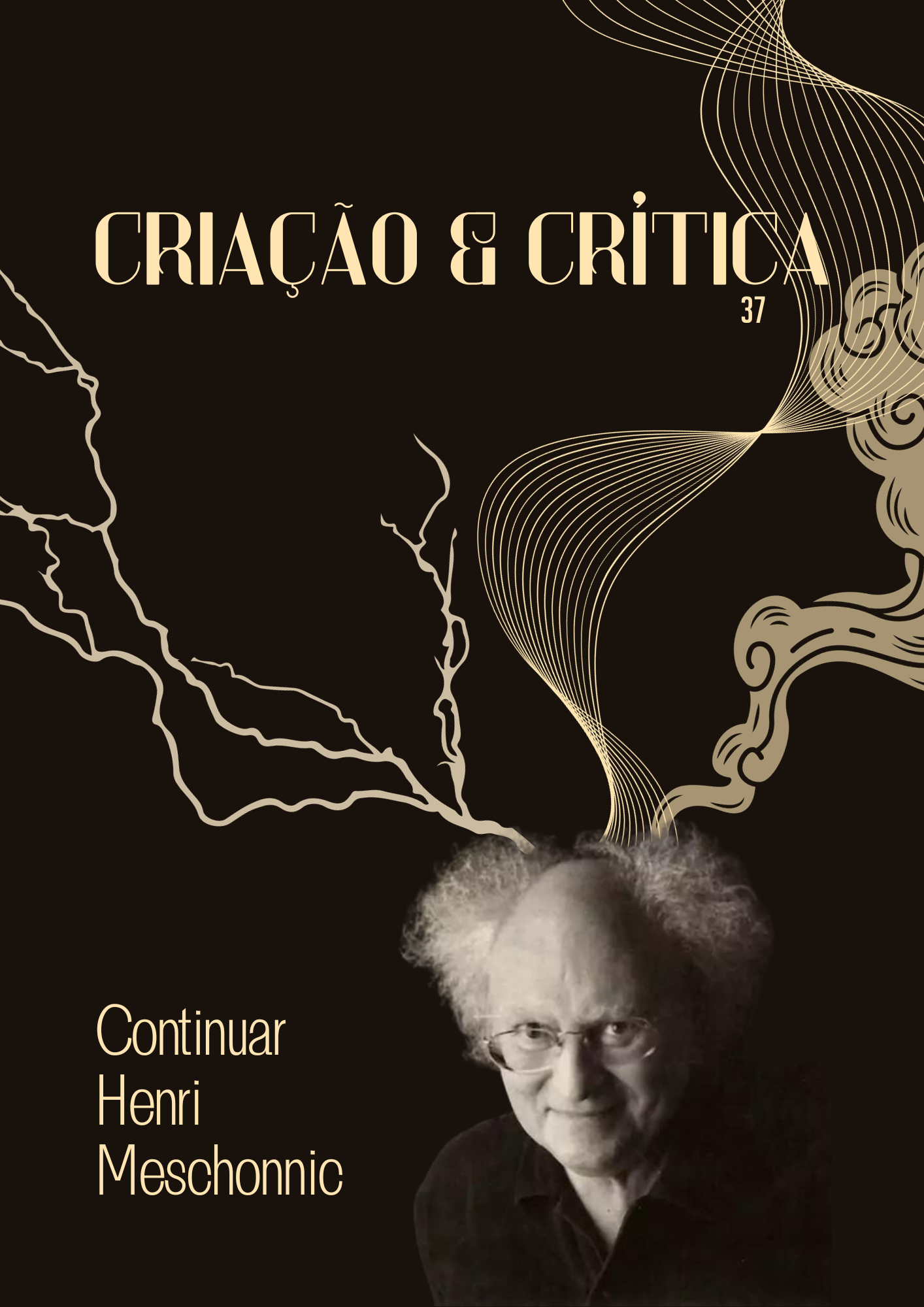Countless rhythms: encounters between Henri Meschonnic and Samuel Beckett
DOI:
https://doi.org/10.11606/issn.1984-1124.i37p68-94Keywords:
Henri Meschonnic, Samuel Beckett, RhythmAbstract
The article discusses affinities and oblique relationships between Henri Meschonnic and Samuel Beckett, based on an analytical journey through texts from the collection Têtes-mortes (1972), representative of late Beckettian fiction. To do so, it mobilizes Meschonnic's discussions around the issues of rhythm, significance, the subject and the “modernity of modernity” and points out dialogues and contrasts between readings of Beckett's works by Meschonnic, Wolfgang Iser and Theodor Adorno.
Downloads
References
AGAMBEN, Giorgio. Homo sacer. O poder soberano e a vida nua – I. Belo Horizonte: UFMG, 2010.
AGAMBEN, Giorgio. “O Fim do Poema”. Cacto n.1 (2002): 142-148.
ADORNO, ADORNO, Theodor. “Trying to understand endgame”. New German Critique, n. 26, p. 119-150, primavera-outono, 1982.
ADORNO, ADORNO, Theodor. Aesthetic theory. Londres/ Nova York: Continuum, 1997.
ANDRADE, Fábio de Souza. “Prefácio”. In: BECKETT, Samuel. O despovoador; Mal visto mal dito. Trad. Eloísa Araújo Ribeiro. São Paulo: Martins Fontes, 2008.
BECKETT, Samuel. Têtes-mortes. Paris: Les Éditions de Minuit,1972.
BECKETT, Samuel. Molloy. 2a ed. Paris: Les Éditions de Minuit, 1982.
BECKETT, Samuel. Samuel Beckett: the complete short prose – 1929–1989. Nova York: Grove Press, 1995.
BECKETT, Samuel. Nowhow on. Nova York: Grove Press, 1996.
BECKETT, Samuel. Companhia e outros textos. Trad. Ana Helena Souza. São Paulo: Editora Globo, 2012.
BECKETT, Samuel. Pour en finir encore et autres foirades. Paris: Les Éditions de Minuit, 2013.
BECKETT, Samuel. Comment c’est. Paris: Les Éditions de Minuit, 2015.
BECKETT, Samuel. L’image, Paris: Les Éditions de Minuit, 2018.
BENVENISTE, Émile. “A noção de ‘ritmo’ em sua expressão linguística”. Problemas de linguística geral I. Pontes Editores: São Paulo, 2005.
BOURASSA, Lucie. Henri Meschonnic. Pour une poétique du rythme. Paris: Bertrand-Lacoste, 1997.
BRATER, Enoch. The Drama in the Text: Beckett's Late Fiction. Oxford: Oxford University Press, 1994.
BRUYN, Ben de. Wolfgang Iser. A companion. Berlim: De Grutyer, 2012.
CASELLI, Claudia. Beckett’s Dantes. Intertextuality in the fiction and criticism. Manchester: Palgrave, 2005. Michigan: University of Michigan Press, 2013.
COHN, Ruby. Back to Beckett. Princeton: Princeton University Press, 1973.
COHN, Ruby. A Beckett canon. Michigan: University of Michigan Press, 2010.
CONNOR, Steven. Beckett, Modernism and the Material Imagination. Cambridge: Cambridge University Press, 2014.
CUNNINGHAM, David. “Asceticism against colour, or modernism, abstraction and the lateness of Beckett”. New Formations n. 55, pp. 104-119, 2005.
DEGUY, Michel. “JE – TU – IL”. RABATÉ, D.; DE SERMET, J.; VADÉ, Y. (orgs.). Le Sujet lyrique en question. Bordeaux: Presses Universitaires de Bordeaux, 1996. GATTI, Luciano. “Adorno e Beckett: aporias da autonomia do drama”. Kriterion, nº 130, p. 577-596, 2014.
GOLDFEDER, André. “El cubo y el azul. Ecos y huecos de poesía en Sans/Lessness”. Beckettiana n. 20, Buenos Aires. 2024 (no prelo).
GOLDFEDER, André. “Dois não cubos. Aproximações a Sans a partir de Le cube et le visage”. Literatura e sociedade (número por definir), São Paulo, 2024a (no prelo).
ISER, Wolfgang. The implied reader. Baltimore: Johns Hopkins University Press, 1975.
ISER, Wolfgang. “Os atos de fingir ou o que é fictício no ficcional”. In: LIMA, Luiz Costa. Teoria da literatura em suas fontes: vol. II. 2. ed. Rio de Janeiro: Francisco Alves, 1983.
ISER, Wolfgang. O fictício e o imaginário. Rio de Janeiro: Eduerj, 2013.
LARRUE, Jean-Marc. “Théatre et intermedialité: une rencontre tardive”. Intermedialités, Montreal, n. 12, p. 13-29, 2009.
KNOLWSON, James. Damned to fame: the life of Samuel Beckett. Londres: Bloomsbury, 1997.
MAINGUENEAU, Dominique. O contexto da obra literária: enunciação, escritor, sociedade. São Paulo: Martins Fontes, 2012.
MANIGLIER, Patrice. “Surdétermination et duplicité des signes: de Saussure à Freud”. Savoirs et Clinique. Paris, n. 6, p. 149-160, 2005.
MESCHONNIC, Henri. Critique du rythme. Anthropologie historique du langage. Paris: Verdier, 1982.
MESCHONNIC, Henri. Les états de la poétique. Paris: PUF, 1985.
MESCHONNIC, Henri.(1985a), “Mallarmé au-delà du silence”. in MALLARMÉ, S. Écrits sur le livre. Paris, Éditions de l’Éclat, 1985a.
MESCHONNIC, Henri.Poética do traduzir. São Paulo: Perspectiva, 2010.
MESCHONNIC, Henri.Linguagem, ritmo e vida. Tradução de Cristiano Florentino. Belo Horizonte: FALE/UFMG, 2006.
MESCHONNIC, Henri. Modernidade, modernidade. São Paulo: Edusp, 2017.
MESCHONNIC, Henri. “Para sair do pós-moderno”. In: MARTINS, M. S. (org.) Henri Meschonnic: Ritmo, Historicidade e a Proposta de uma Teoria Crítica da Linguagem. Campinas: Mercado de Letras, 2022.
MESCHONNIC, Henri. Linguagem, história uma mesma teoria (excertos). In: MARTINS, M. S. (org.) Henri Meschonnic: Ritmo, Historicidade e a Proposta de uma Teoria Crítica da Linguagem. Campinas: Mercado de Letras, 2022a.
PERLOFF, Marjorie. “‘The space of a door. Beckett and the poetry of absence”. In: The Poetics of Indeterminacy. Rimbaud to Cage. Evanston: Northwestern University Press, 1999.
RABINOVITZ, Rubin. “‘Molloy' and the archetypal traveller”. Journal of Beckett Studies. Endimburgo, n. 5. pp. 25-44, 1979.
SHAKESPEARE, William. Rei Lear. São Paulo: Companhia das Letras, 2020.
Downloads
Published
Issue
Section
License

This work is licensed under a Creative Commons Attribution-NonCommercial-ShareAlike 4.0 International License.
Authors who publish with this journal agree to the following terms:
- Authors retain copyright and grant the journal right of first publication with the work simultaneously licensed under a Creative Commons Attribution License that allows others to share the work with an acknowledgment of the work's authorship and initial publication in this journal.
- Authors can enter into separate, additional contractual arrangements for the non-exclusive distribution of the journal's published version of the work (e.g., post it to an institutional repository or publish it in a book), with an acknowledgment of its initial publication in this journal.
- Authors are permitted and encouraged to post their work online (e.g., in institutional repositories or on their website) before and during the submission process, as it can lead to productive exchanges, as well as earlier and greater citation of published work (See The Effect of Open Access).
Funding data
-
Fundação de Amparo à Pesquisa do Estado de São Paulo
Grant numbers 2019/13591-3



